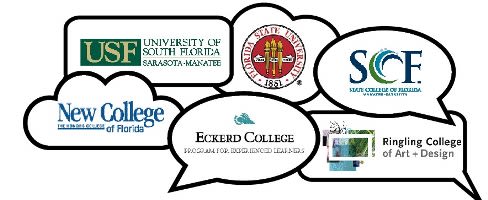Education Report: College Collaborations
Educational institutions pool their resources for the benefit of students, business and community.
By Abby Weingarten

Envision a town in which students hop from one college to another, taking full advantage of the educational resources at every local institution. According to the leaders at area colleges and universities, it’s time to combine the power of their institutions and work together.
Spearheading this initiative is the Gulf Coast College Collaborative (GC3)—the “3” stands for the three “C” words in the name. It’s comprised of the leaders of New College of Florida, Ringling College of Art and Design, State College of Florida and the University of South Florida Sarasota-Manatee. Eckerd College and Florida State University, which operates the John and Mable Ringling Museum of Art, have also joined the discussion. Since launching last spring, GC3 leaders have brought together some of their top academic, student affairs, business and communications advisers to share ideas.
AIM OF THE GC3 GROUP
The goal is to help attract prospective students and employers, and to engage donors by enhancing Sarasota-Manatee’s reputation as an academic center. Regions with strong educational institutions attract entrepreneurs, the affluent, corporate donors and jobs. Except for Eckerd, the local institutions involved are all within six miles of one another, so combined, they make a large academic footprint.
COLLABORATIVE EFFORTS
One goal is to realize economies of scale where they exist and to share best practices. Models such as the New York 6 (six New York-based liberal arts colleges), the Five-College Consortium (five colleges in western Massachusetts) and the Seven Sisters (seven colleges in the northeastern U.S.) have had great successes by sharing resources with universities and colleges that have very different missions. These programs emphasize and preserve individual identities while collaborating on the strengths of their programs. In a perfect world, students here will move seamlessly from institution to institution. The institutions will collaborate on specific degrees to avoid duplication. They also can share resources. This already takes place on an informal scale, but GC3 wants to be more intentional and strategic in collaborating.
IMPACT
The institutions want to provide diverse educational opportunities that they cannot provide to students or supporters individually. They want local residents to stay here and realize the rich educational opportunities (both degree and nondegree), and they want to attract those who are looking for the experience of a larger college community. The future outcome would be a town in which 18- to 28-year-olds would enjoy more social and recreational activities, career opportunities and lifestyle enhancements. Employers would find talented employees and the region would retain more young professionals in Sarasota and Manatee after graduation.
SHARING STUDENTS
A significant amount of student “hopping” already is going on due to the success of agreements between various institutions. For example, State College of Florida students and graduates matriculate to several programs at USFSM, New College, Ringling and Eckerd; New College and USFSM also share some services.
STUDENT CENTER
There is a vision for a hub or physical space but no immediate plans. By reaching out to each other’s students, the institutions hope to create opportunities for “meeting places” to evolve organically.
CURRENT PROJECTS
The GC3 group already has started sharing educational and entertainment opportunities with each other’s students, faculty, staff and community partners. They are considering cost sharing to bring in speakers, develop programs and increase institutional effectiveness. College and university business officers are discussing information-sharing sessions about campus security, as well as a plan for sharing facilities and resources in the wake of weather disasters.